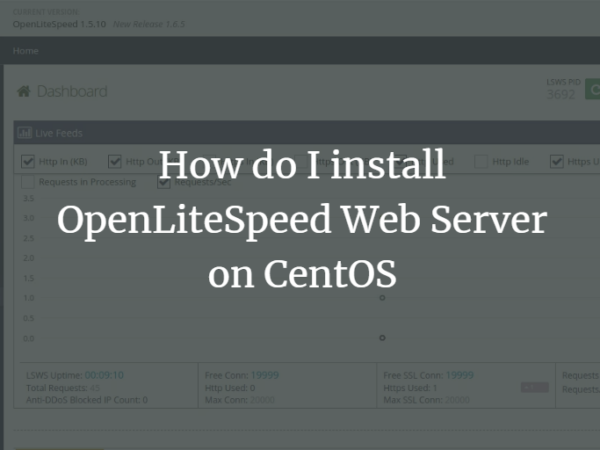Drupal is a free and open-source content management platform created for professional content creation in an efficient manner. Drupal enables you to create websites, online content and user engagement communities with ease. Drupal is written in PHP and it uses a database backend to store its data – MySQL, MariaDB, SQLite or PostgreSQL. This guide will show you the steps required to install and configure Drupal 9 on CentOS 7 Linux system.
Below are the minimum requirements for running Drupal 9 on CentOS 7:
- PHP >=7.3
- MySQL or Percona, version >=5.7.8
- MariaDB >=10.3.7
- PostgreSQL >=10
Some features of Drupal 9 are:
- Layout Builder: Allows content editors to design pages without engineering help
- API-first architecture: Enables building robust decoupled and headless applications
- Media Library: Makes the management of images, video, and other assets easier than ever before.
- Automated updates
- New admin interface and default theme
In this section we will cover installation of dependencies required to run Drupal on CentOS 7. The web server that is used in this guide is Apache but you have the option of using Nginx or any other web server. One of the good features of Drupal is its level of customization with many addons available.
Step 1: Install Database server
Choose a database server you want to use, this can be MySQL, MariaDB or PostgreSQL. In this guide we will use MariaDB database server.
Update and reboot your system before database installation:
sudo yum -y update
sudo systemctl rebootThen refer to our guide on installation of MariaDB on CentOS 7:
How To Install MariaDB on CentOS 7
Step 2: Create Drupal Database
A database and user is required by Drupal CMS to be functional. Open MariaDB shell.
$ mysql -u root -pCreate database and user for Drupal.
CREATE DATABASE drupal;
GRANT ALL ON drupal.* TO 'drupal'@'localhost' IDENTIFIED BY '[email protected]';
FLUSH PRIVILEGES;
qStep 3: Install PHP and required extensions
We need to install PHP 7.3 or higher version for Drupal 9. For this installation EPEL and REMI repositories are required:
sudo yum -y install http://rpms.remirepo.net/enterprise/remi-release-7.rpm
sudo yum -y install epel-releaseEnable PHP 7.3 REMI repository:
sudo yum -y install yum-utils
sudo yum-config-manager --disable remi-php54
sudo yum-config-manager --enable remi-php73Install PHP 7.3 on CentOS 7:
sudo yum -y install php php-{cli,gd,mysqlnd,mbstring,json,common,dba,dbg,devel,embedded,enchant,bcmath,gmp,intl,ldap,odbc,pdo,opcache,pear,pgsql,process,recode,snmp,soap,xml,xmlrpc}Confirm PHP version:
$ php -v
PHP 7.3.19 (cli) (built: Jun 9 2020 08:06:30) ( NTS )
Copyright (c) 1997-2018 The PHP Group
Zend Engine v3.3.19, Copyright (c) 1998-2018 Zend TechnologiesStep 4: Install Web Server
In this guide, we’ll go with Apache as Web server for Drupal on CentOS 7:
sudo yum -y install httpdSet PHP Timezone and memory limit.
$ sudo vi /etc/php.ini
memory_limit = 256M
date.timezone = Africa/NairobiStart and enable httpd service.
sudo systemctl enable --now httpdAllow http and https protocols in the firewall.
sudo firewall-cmd --add-service={http,https} --permanent
sudo firewall-cmd --reloadCheck if httpd service is running:
$ systemctl status httpd
● httpd.service - The Apache HTTP Server
Loaded: loaded (/usr/lib/systemd/system/httpd.service; enabled; vendor preset: disabled)
Active: active (running) since Sun 2020-06-28 16:24:26 CEST; 2min 48s ago
Docs: man:httpd(8)
man:apachectl(8)
Process: 2708 ExecStop=/bin/kill -WINCH ${MAINPID} (code=exited, status=0/SUCCESS)
Main PID: 2713 (httpd)
Status: "Total requests: 0; Current requests/sec: 0; Current traffic: 0 B/sec"
CGroup: /system.slice/httpd.service
├─2713 /usr/sbin/httpd -DFOREGROUND
├─2714 /usr/sbin/httpd -DFOREGROUND
├─2715 /usr/sbin/httpd -DFOREGROUND
├─2716 /usr/sbin/httpd -DFOREGROUND
├─2717 /usr/sbin/httpd -DFOREGROUND
└─2718 /usr/sbin/httpd -DFOREGROUND
Jun 28 16:24:26 centos.computingforgeeks.com systemd[1]: Starting The Apache HTTP Server...
Jun 28 16:24:26 centos.computingforgeeks.com systemd[1]: Started The Apache HTTP Server.Step 5: Download Drupal 9 on CentOS 7
Download the Drupal 9 tarball:
sudo yum install -y wget
wget https://www.drupal.org/download-latest/tar.gz -O drupal.tar.gzExtract downloaded file.
tar xvf drupal.tar.gzMove resulting folder to /var/www/html directory.
rm -f drupal*.tar.gz
sudo mv drupal-*/ /var/www/html/drupalConfirm file contents:
$ ls /var/www/html/drupal
autoload.php core INSTALL.txt profiles sites vendor
composer.json example.gitignore LICENSE.txt README.txt themes web.config
composer.lock index.php modules robots.txt update.phpCreate additional directories and files required by Drupal installer.
sudo mkdir /var/www/html/drupal/sites/default/files
sudo cp /var/www/html/drupal/sites/default/default.settings.php /var/www/html/drupal/sites/default/settings.phpSet ownership of drupal directory to Apache user and group.
sudo chown -R apache:apache /var/www/html/
sudo chmod -R 755 /var/www/html/Fix SELinux Labels:
sudo semanage fcontext -a -t httpd_sys_rw_content_t "https://computingforgeeks.com/var/www/html/drupal(/.*)?"
sudo semanage fcontext -a -t httpd_sys_rw_content_t '/var/www/html/drupal/sites/default/settings.php'
sudo semanage fcontext -a -t httpd_sys_rw_content_t '/var/www/html/drupal/sites/default/files'
sudo restorecon -Rv /var/www/html/drupal
sudo restorecon -v /var/www/html/drupal/sites/default/settings.php
sudo restorecon -Rv /var/www/html/drupal/sites/default/filesStep 6: Configure Apache for Drupal
Create a new Apache configuration for Drupal website.
sudo vi /etc/httpd/conf.d/drupal.confModify below content and add to file – set domain, admin user and correct path to Drupal data.
ServerName mysite.com
ServerAlias www.mysite.com
ServerAdmin [email protected]
DocumentRoot /var/www/html/drupal/
CustomLog /var/log/httpd/access_log combined
ErrorLog /var/log/httpd/error_log
Options Indexes FollowSymLinks
AllowOverride All
Require all granted
RewriteEngine on
RewriteBase /
RewriteCond %{REQUEST_FILENAME} !-f
RewriteCond %{REQUEST_FILENAME} !-d
RewriteRule ^(.*)$ index.php?q=$1 [L,QSA]
Confirm configuration syntax:
$ sudo apachectl -t
Syntax OKRestart httpd web server.
systemctl restart httpdStep 7: Install Drupal 9 on CentOS 7
Open your favorite web browser to finish the installation of Drupal 9 on CentOS 7.
Choose an installation Language:
Choose installation profile to be used.
Set Database access details as configured earlier for Drupal:
Wait for it to be completed:
Configure your site:
When done you’ll be directed to website administration console.
Refer to the official documentation for more more reading on Drupal customizations and other configuration options.
For https access, check Drupal SSL Configuration guide
Installation on other systems:
Install Drupal 9 CMS on Ubuntu
Books to read:
Best Books to learn Web Development – PHP, HTML, CSS, JavaScript and jQuery



